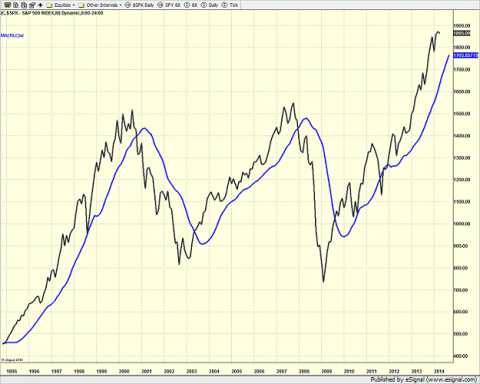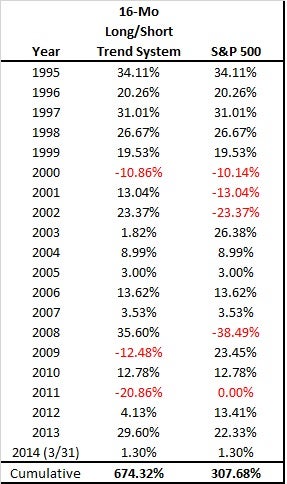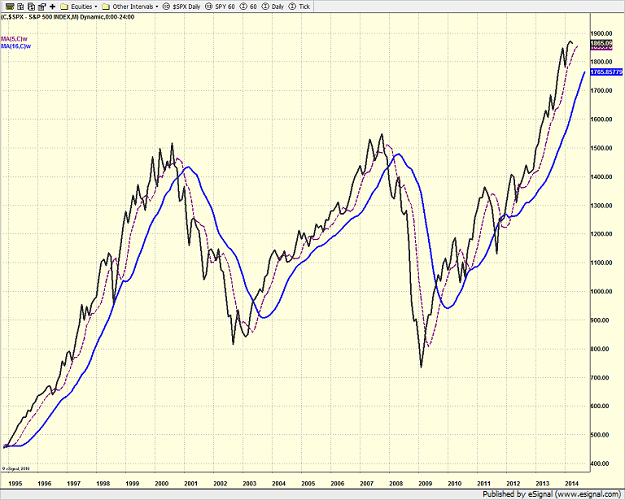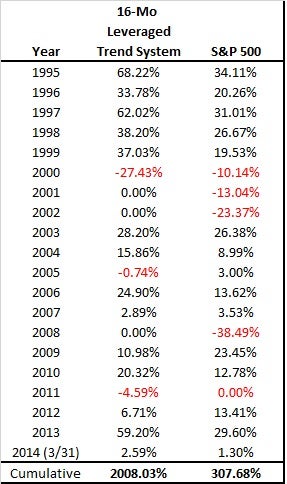With the blood-letting taking a break, now would be a good time to continue exploring a simple, yet effective, trend-following system designed to keep investors on the right side of the market's really big, really important moves.
But first there are the caveats. Please keep in mind that the results shown in this report are purely hypothetical.
The numbers do not represent actual trading and do not take into account commissions, taxes, slippage, interest on money market etc.
And we should also note that we do not utilize this specific approach at our shop as there are definitely pitfalls to using a single indicator.
To review, let's start with a monthly chart of the S&P 500.
We then add in a 16-month, weighted moving average to a monthly chart. Next, we move the moving average forward five months.
Traders can think of this as sliding the moving average to the right a bit to help avoid whipsaws. The moving average is the blue line on the chart below.
S&P 500 Monthly from 1995

To review, the plan is to be long the S&P when price is above the moving average and to be in cash when price is below the moving average.
The results of such an approach are more than 77 percent better than that of the buy-and-hold of the S&P itself (+546 percent vs. +308 percent) and are also a bit better than our original goal of capturing 70 percent of bull market gains and avoiding 50 percent of bear market losses (which would have produced a cumulative gain +425 percent).
So, all in all, the base-level approach isn't too shabby.
But We Can Do Better, Right?
While this was not the case even 10 years ago, today, investors know that they can play both sides of market trends. These days, creating a synthetic short is easily accomplished by purchasing an inverse ETF such as ProShares Short S&P 500 ETF SH.
So, the next step in the system development process is to try to play both sides of the big moves by being long the S&P when the index is above the 16-month weighted moving average (moved forward five months) and to be short the S&P when the index is below the moving average.
Frankly, this is an uber-simplistic approach and flies in the face of our belief that one should not use the same indicator to produce long and short signals. But again, our goal here is to K.I.S.S. (keep it super simple) and to provide an actionable idea that investors could use and/or build on.
So, let's get to the numbers...

Most eyes likely immediately go to the cumulative results.
So, the bottom line is using a long/short approach does indeed improve the overall returns over the long/cash strategy (+674 percent vs. +546 percent).
However, due to the fact that stocks go down something like three times as fast as they go up, the long/short approach creates a significantly bumpier ride.
While the returns during bear markets improve dramatically (see 2000-02 and 2008), using a long/short approach would have proved VERY hard to live with during 2009, 2011 and 2012.
Generally speaking, investors are "long-term" as "long" as they are making money. So, given that the long/short approach was a bit of a train-wreck in both 2009 and 2011 (and then underperformed again in 2012), it is a safe bet that a great many investors would have given up on the system by the time 2013 rolled around.
Based on this knowledge, we decided to take a slightly different tack.
Let's Add Some Leverage
Using the assumptions that:
- (a) most investors would have given up on the long/short system in 2009-2012,
- (b) it was the losses on the short positions that caused all the trouble,
- (c) it is a bad idea to assume the same signal can work equally well for both the long and short side, and
- (d) we wanted to keep this approach VERY simple, we made the decision to kill the short signals and instead utilize some leverage.
Like the idea of creating a short position via an inverse ETF, the concept of easily and cheaply adding leverage to a position didn't exist 10 years ago. Sure there were margin accounts, options or futures available, but each brings new complications to the game.
But my how times have changed!
There are now any number of ETFs and Mutual Funds that are designed to deliver 2X or even 3X the daily return of the S&P 500 SPY, the NASDAQ QQQ, the Russell 2000 IWM and the Midcaps MDY. Therefore, adding some "leverage" to a strategy is a snap in today's market.
Introducing The Leverage Trigger
However, blindly being 2X or 3X long the stock market at all times can be, well, dangerous. Trust me, you do NOT want to be holding a 2X long ETF or Mutual Fund when the S&P experiences a 10 - 15 percent correction. The bottom line is your account value can get ugly, very fast when things go against you for a protracted period.
Because of this, we wanted to create a signal or a "trigger" to tell us when to be leveraged long and when not to be.
Enter the "leverage trigger." Here's how it works. Take a look at the chart below. The purple dashed line is a 5-month weighted moving average, moved forward 2 months. In short, this line will act as our leverage trigger.
When the S&P is above the purple line, you can hold a leveraged long position. And when the index moves below the purple dashed line (but remains above the solid blue line), the plan is to reduce leverage and simply hold the S&P 500.
S&P 500 Monthly from 1995

The idea is pretty straightforward. When the S&P 500 is above the leverage trigger and the leverage trigger itself is rising, it means the odds favor the bulls. So, experience tells us to go ahead and put the pedal to the metal and use some leverage.
But when the S&P 500 moves below the leverage trigger, it means that a short- to intermediate-term correction may be taking place.
And while, our long-term, big-picture strategy isn't designed to try and dodge such events, it is definitely a good idea to take less risk during this type of environment.
The Levered Strategy
Here are the rules we employed for our hypothetical back-test. When the S&P 500 was above the blue line, we held the S&P 500. When the S&P 500 was above the purple dashed line (aka the leverage trigger), we held a 2X long position.
When the S&P 500 moved below the leverage trigger, we moved from a 2X long position to a 1X long position. And when the S&P 500 moved below the blue line, we moved to cash. (And for the record, when the S&P 500 is below the blue line, but above the purple line, no action was taken.)
Here are the results of the hypothetical backtest.

Okay, NOW we're talking: +2,008 percent vs. +308 percent - nice.
Since we are using a leveraged strategy, those extended bull markets create very impressive results. And since the system is designed to largely get out of the way of big, bad bear markets, losses were also limited during periods like 2000-2002 and 2008. Not bad.
But, There Are Some Drawbacks to Be Aware Of
However... there are drawbacks to this system (as there are with any and ALL systems). First and foremost, the way the leverage trigger functions, investors are forced to add leverage when the market is moving higher and to cut leverage when the market is moving down. (Again, we wanted a simple, trend-oriented system.) As such, the inherent drawbacks to trend-following (i.e. whipsaws) still apply as buying high and selling low is still not fun - but it DOES happen.
So, years like 2000, 2005, 2009, 2011 and 2012 were no picnics. However, since the only REALLY bad year in terms of absolute return was 2000, my guess is that this is a system that investors could probably live with for the long-term.
Is this perfect? Uh no. But we were tasked with coming up with something that was
- (a) easy to use, and
- (b) didn't require any fancy models or difficult math.
In Sum...
In summary, the very simple monthly trend-following system we've reviewed does a decent job of getting the really big, really important moves right. However, as is the case with ANY system, there are "issues" to deal with along the way.
So, given that the really trick to this game is to be able to stick with your strategy for the long-term, it is important to fully understand the pluses and minuses of a given approach. In addition, it is HIGHLY recommended that investors utilize multiple strategies in their overall portfolio. This limits the potential damage to one's account value during those inevitable times when an approach falls out of favor (and remember, they ALL do from time to time).
However, it is our sincere hope that the explanation of our simple, monthly trend-following system can spur some ideas for your overall investing strategy.
Positions in stocks mentioned: SPY
Edge Rankings
Price Trend
© 2025 Benzinga.com. Benzinga does not provide investment advice. All rights reserved.
Trade confidently with insights and alerts from analyst ratings, free reports and breaking news that affects the stocks you care about.